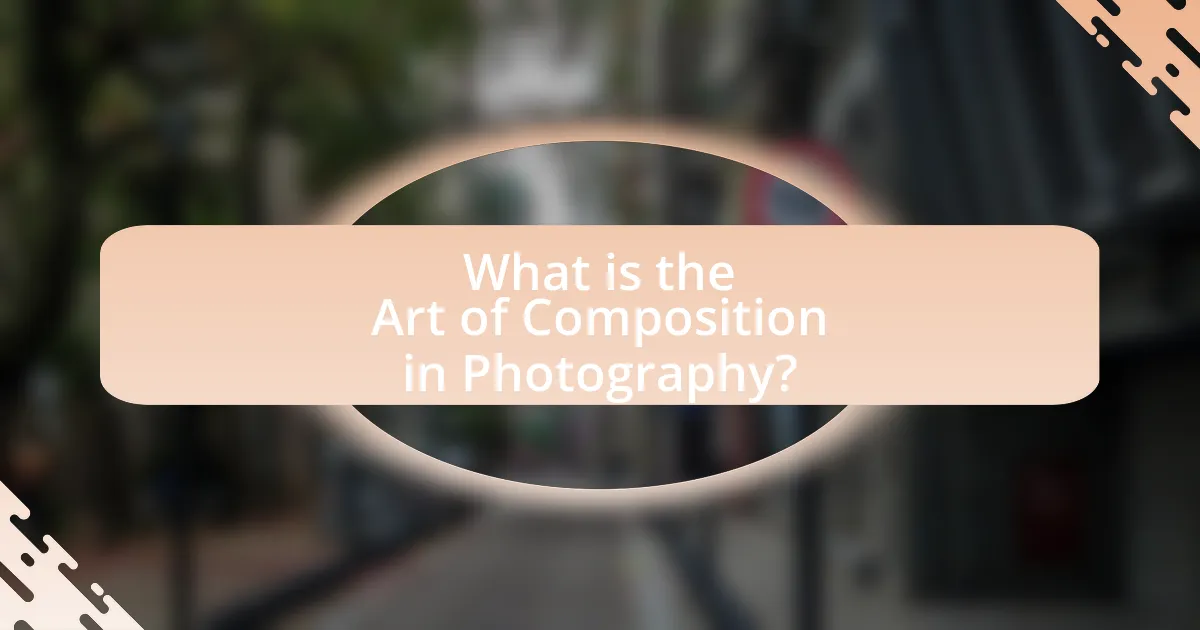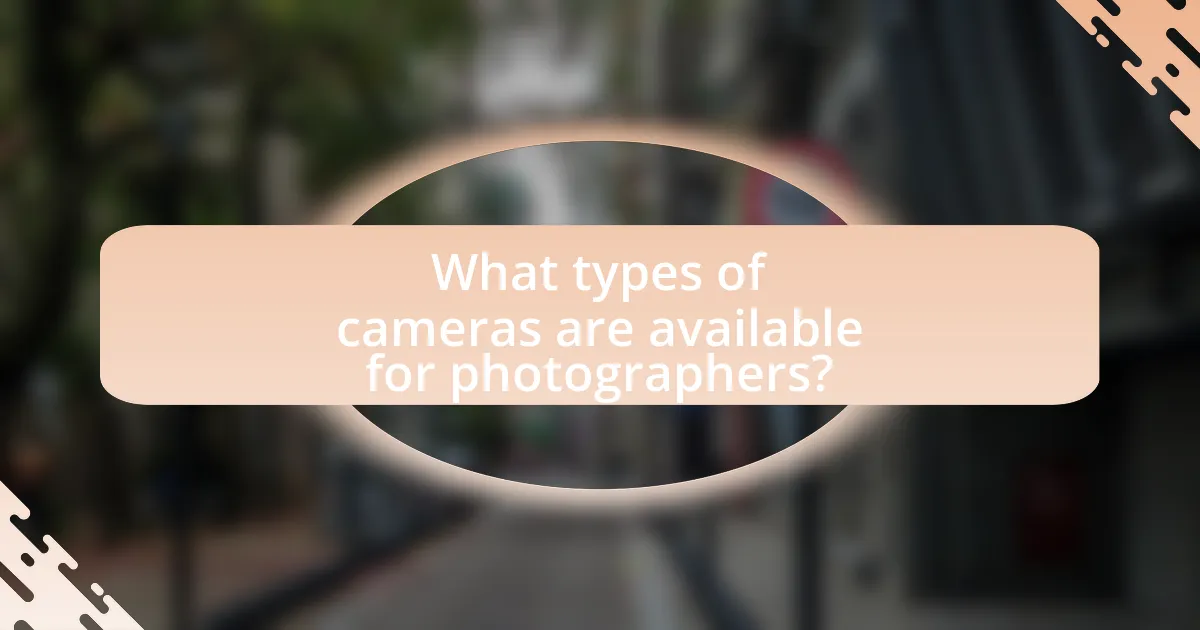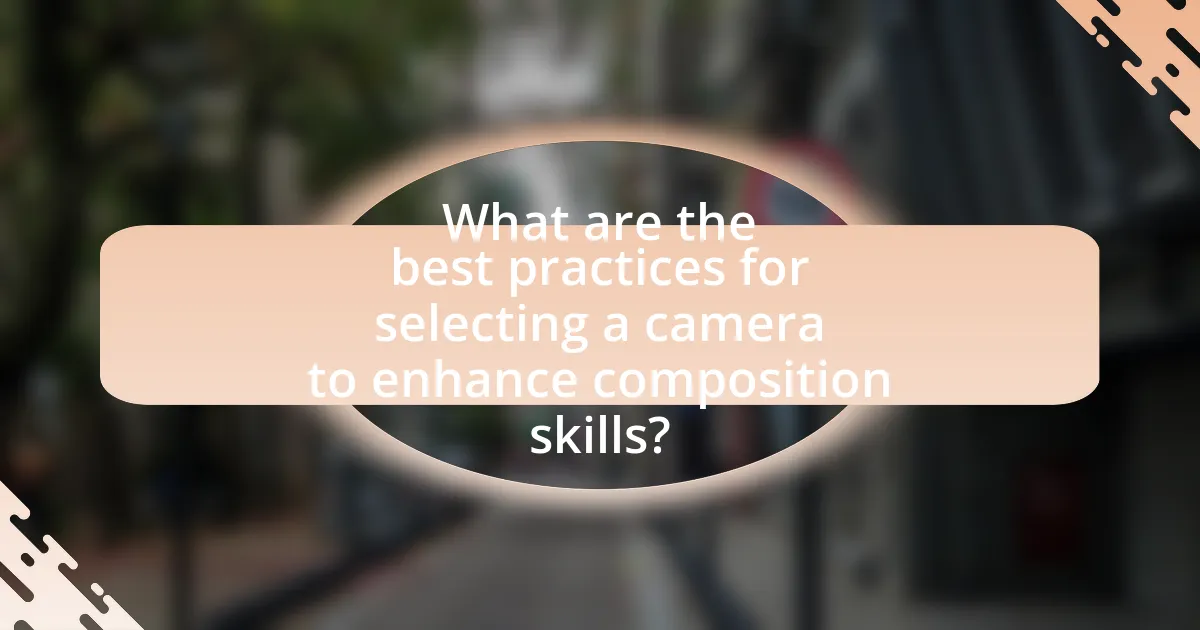The article focuses on the Art of Composition in Photography, emphasizing the arrangement of visual elements to create balanced and engaging images. It explores how composition influences the quality of photographs through principles such as balance, contrast, and the rule of thirds. Additionally, the article discusses the importance of selecting the right camera and lenses, detailing how different camera types and features impact compositional choices. It also provides practical tips for improving composition skills, common mistakes to avoid, and the significance of understanding camera settings to enhance visual storytelling.

What is the Art of Composition in Photography?
The Art of Composition in Photography refers to the arrangement of visual elements within a photograph to create a balanced and engaging image. This involves principles such as the rule of thirds, leading lines, and framing, which guide the viewer’s eye and enhance the overall aesthetic. Effective composition can significantly impact the emotional response and storytelling aspect of a photograph, as evidenced by studies showing that well-composed images are more likely to capture attention and evoke feelings.
How does composition influence the overall quality of a photograph?
Composition significantly influences the overall quality of a photograph by determining how elements are arranged within the frame, which affects visual impact and storytelling. Effective composition guides the viewer’s eye, creates balance, and emphasizes the subject, leading to a more engaging image. For instance, the rule of thirds, a fundamental compositional guideline, suggests placing key elements along imaginary lines that divide the frame into thirds, enhancing visual interest and harmony. Research by the National Geographic Society indicates that well-composed images are more likely to capture attention and evoke emotional responses, underscoring the importance of composition in photography.
What are the fundamental principles of composition?
The fundamental principles of composition include balance, contrast, emphasis, movement, pattern, rhythm, and unity. These principles guide the arrangement of elements within a visual work to create a cohesive and engaging image. For instance, balance ensures that visual weight is distributed evenly, while contrast highlights differences between elements, drawing attention to focal points. Emphasis directs the viewer’s gaze to the most important part of the composition, and movement guides the viewer’s eye through the artwork. Pattern and rhythm create a sense of organization and flow, while unity ensures that all elements work together harmoniously. These principles are essential for effective visual storytelling and are widely recognized in art and photography.
How do different compositional techniques affect viewer perception?
Different compositional techniques significantly influence viewer perception by guiding attention, evoking emotions, and establishing context. For instance, the rule of thirds creates balance and interest, leading viewers to engage more deeply with the subject. In contrast, leading lines direct the viewer’s gaze toward focal points, enhancing narrative clarity. Research by Kosslyn et al. (1993) in “The Role of Visual Imagery in the Perception of Spatial Layout” demonstrates that structured compositions can improve cognitive processing of visual information, thereby affecting how viewers interpret and respond to images.
Why is selecting the right camera essential for enhancing composition skills?
Selecting the right camera is essential for enhancing composition skills because it directly influences the photographer’s ability to frame, focus, and capture images effectively. A camera with appropriate features, such as adjustable settings for aperture, shutter speed, and ISO, allows photographers to experiment with different compositions and understand the impact of these variables on the final image. For instance, a DSLR or mirrorless camera provides greater control over depth of field and exposure, enabling more creative and precise compositions compared to a basic point-and-shoot camera. This capability is supported by studies indicating that photographers who utilize advanced camera systems report improved satisfaction and skill development in their compositional techniques.
What features should photographers consider when choosing a camera?
Photographers should consider sensor size, lens compatibility, autofocus system, image stabilization, and ISO range when choosing a camera. Sensor size affects image quality and depth of field; larger sensors typically produce better low-light performance and dynamic range. Lens compatibility is crucial as it determines the variety of lenses available for different shooting styles. A robust autofocus system enhances the ability to capture sharp images, especially in fast-moving situations. Image stabilization helps reduce blur from camera shake, particularly in low-light conditions or when using telephoto lenses. Lastly, a wide ISO range allows for flexibility in various lighting environments, enabling photographers to achieve optimal exposure without sacrificing image quality.
How does camera type impact compositional choices?
Camera type significantly impacts compositional choices by influencing perspective, depth of field, and framing options. Different camera types, such as DSLRs, mirrorless cameras, and smartphones, offer varying sensor sizes and lens options, which directly affect how subjects are captured. For instance, DSLRs and mirrorless cameras typically allow for interchangeable lenses, enabling photographers to choose wide-angle or telephoto lenses that can dramatically alter composition by changing the field of view and perspective. In contrast, smartphones often have fixed lenses, limiting compositional flexibility but allowing for quick, spontaneous shots. Additionally, larger sensors in DSLRs and mirrorless cameras provide better control over depth of field, allowing for more pronounced background blur (bokeh) that can enhance subject isolation in a composition. This relationship between camera type and compositional choices is evident in professional photography, where the choice of equipment is often tailored to achieve specific artistic effects.

What types of cameras are available for photographers?
Photographers have access to several types of cameras, including DSLR cameras, mirrorless cameras, compact cameras, and medium format cameras. DSLR cameras, known for their optical viewfinders and interchangeable lenses, are favored for their versatility and image quality. Mirrorless cameras, which lack a mirror mechanism, offer a more compact design and faster shooting speeds, making them popular among both amateurs and professionals. Compact cameras, or point-and-shoots, are user-friendly and portable, ideal for casual photography. Medium format cameras provide larger sensors for exceptional detail and dynamic range, often used in high-end commercial photography. Each type serves different needs and preferences, allowing photographers to choose based on their specific requirements and style.
What are the differences between DSLR, mirrorless, and compact cameras?
DSLR, mirrorless, and compact cameras differ primarily in their design, functionality, and image quality. DSLRs utilize a mirror mechanism to reflect light from the lens to an optical viewfinder, offering fast autofocus and extensive lens options, making them suitable for professional photography. Mirrorless cameras, on the other hand, lack a mirror system, allowing for a more compact design and typically faster shooting speeds, while also providing high-quality images and interchangeable lenses. Compact cameras are smaller and more user-friendly, often featuring fixed lenses and automatic settings, making them ideal for casual photography but generally offering lower image quality compared to DSLRs and mirrorless systems. These distinctions highlight the varying capabilities and use cases of each camera type, catering to different levels of photography expertise and preferences.
How does sensor size affect image quality and composition?
Sensor size significantly impacts image quality and composition by influencing factors such as depth of field, dynamic range, and noise levels. Larger sensors typically capture more light, resulting in better low-light performance and reduced noise, which enhances overall image quality. For instance, full-frame sensors often provide a wider dynamic range compared to crop sensors, allowing for more detail in highlights and shadows. Additionally, larger sensors enable a shallower depth of field, facilitating creative control over focus and background blur, which is crucial for artistic composition. This relationship between sensor size and image characteristics is supported by various studies, including those that demonstrate how full-frame cameras outperform crop sensors in low-light scenarios and dynamic range capabilities.
What are the advantages and disadvantages of each camera type?
Digital cameras offer advantages such as instant image review, high storage capacity, and the ability to shoot in various lighting conditions due to advanced sensors. However, they can be expensive and may require frequent battery charging. Film cameras, on the other hand, provide a unique aesthetic and dynamic range, often preferred by purists, but they involve higher costs for film and development, and lack immediate feedback. Mirrorless cameras are compact and versatile, allowing for interchangeable lenses and electronic viewfinders, yet they may have shorter battery life and limited lens options compared to DSLRs. DSLRs excel in autofocus performance and battery longevity, but they tend to be bulkier and heavier. Each camera type has distinct advantages and disadvantages that cater to different photography needs and preferences.
How do lens choices influence composition in photography?
Lens choices significantly influence composition in photography by affecting perspective, depth of field, and framing. Different focal lengths alter how subjects are perceived; for instance, wide-angle lenses create a sense of space and can exaggerate foreground elements, while telephoto lenses compress distances and isolate subjects. Additionally, lens aperture settings determine depth of field, allowing photographers to control the sharpness of the background and foreground, which is crucial for directing viewer attention. For example, a shallow depth of field achieved with a wide aperture can isolate a subject against a blurred background, enhancing compositional focus. Thus, the selection of lens directly impacts how a scene is captured and interpreted, shaping the overall visual narrative.
What types of lenses are best for various compositional styles?
Wide-angle lenses are best for landscape and architectural photography, as they capture expansive scenes and emphasize depth. Telephoto lenses excel in portraiture and wildlife photography, allowing for close-up details while compressing background elements. Standard lenses, typically around 50mm, are versatile for street photography and general use, providing a natural perspective. Macro lenses are ideal for close-up shots of small subjects, revealing intricate details. Each lens type enhances specific compositional styles by offering unique perspectives and framing options, thus improving the overall photographic outcome.
How does focal length affect perspective and framing?
Focal length significantly influences perspective and framing in photography. A shorter focal length, such as 18mm, creates a wider field of view, emphasizing foreground elements and making them appear larger relative to the background, which can enhance depth. Conversely, a longer focal length, like 200mm, compresses space, making background elements appear closer to the subject and reducing the depth of field, which isolates the subject more effectively. This effect is rooted in the physics of optics, where the focal length determines the angle of view and the perspective distortion experienced in an image.

What are the best practices for selecting a camera to enhance composition skills?
To enhance composition skills, select a camera that offers manual controls, interchangeable lenses, and a viewfinder. Manual controls allow photographers to adjust settings like aperture, shutter speed, and ISO, which are crucial for creative expression and understanding composition. Interchangeable lenses provide versatility in framing and perspective, enabling exploration of different compositions. A viewfinder helps in visualizing the scene and framing shots accurately, which is essential for developing composition skills. Research indicates that photographers who utilize manual settings and diverse lenses report improved compositional understanding and creativity in their work.
How can photographers assess their own needs when choosing a camera?
Photographers can assess their own needs when choosing a camera by evaluating their specific photography style, intended use, and technical requirements. Understanding whether they focus on landscapes, portraits, or action shots helps determine the necessary features, such as sensor size, autofocus capabilities, and lens compatibility. For instance, a photographer specializing in wildlife photography may prioritize a camera with fast autofocus and high frame rates, while a portrait photographer might focus on low-light performance and color accuracy. Additionally, considering factors like budget, portability, and ease of use can further refine their choices, ensuring the selected camera aligns with their creative goals and practical needs.
What role does budget play in selecting a camera for composition?
Budget significantly influences the selection of a camera for composition by determining the quality and features available in the chosen equipment. A higher budget typically allows access to cameras with advanced capabilities such as better sensors, improved low-light performance, and enhanced autofocus systems, which are crucial for achieving desired compositional effects. For instance, professional-grade cameras often provide greater control over settings and superior image quality, enabling photographers to execute their artistic vision more effectively. Conversely, a limited budget may restrict options to entry-level models that might lack essential features, thereby impacting the overall compositional potential.
How can photographers test cameras before making a purchase?
Photographers can test cameras before making a purchase by utilizing hands-on demonstrations at retail stores, renting equipment, or participating in camera testing events. Retail stores often allow potential buyers to handle cameras, providing an opportunity to assess ergonomics, weight, and button layout. Renting cameras from specialized services enables photographers to evaluate performance in real-world conditions, including image quality and autofocus capabilities. Additionally, camera testing events or workshops allow photographers to compare multiple models side by side, facilitating informed decisions based on personal experience and preferences.
What tips can help photographers improve their composition skills with their chosen camera?
To improve composition skills with a chosen camera, photographers should utilize the rule of thirds, leading lines, and framing techniques. The rule of thirds involves dividing the frame into a 3×3 grid and placing key elements along these lines or at their intersections, which enhances visual interest. Leading lines guide the viewer’s eye through the image, creating depth and perspective. Framing techniques involve using elements within the scene to create a ‘frame’ around the subject, drawing attention and adding context. These composition strategies are widely recognized in photography education and are supported by studies showing that images adhering to these principles are often perceived as more aesthetically pleasing.
How can understanding camera settings enhance compositional effectiveness?
Understanding camera settings enhances compositional effectiveness by allowing photographers to control exposure, depth of field, and motion blur, which are critical elements in creating visually compelling images. Mastery of settings such as aperture, shutter speed, and ISO enables photographers to manipulate light and focus, thereby influencing the viewer’s perception and emotional response to the composition. For instance, a wide aperture (low f-stop number) creates a shallow depth of field, isolating the subject from the background and drawing attention to it, which is essential in portrait photography. Conversely, a fast shutter speed freezes motion, making it ideal for action shots, while a slower shutter speed can create a sense of movement in landscapes. This understanding is supported by studies in photography education, which show that students who grasp technical settings produce more impactful compositions, as evidenced by improved critiques in peer-reviewed assessments.
What are common mistakes to avoid when composing photographs?
Common mistakes to avoid when composing photographs include neglecting the rule of thirds, failing to consider the background, and not paying attention to lighting. Neglecting the rule of thirds can lead to unbalanced images; placing the subject off-center often creates a more engaging composition. Failing to consider the background can result in distractions that detract from the main subject, while poor lighting can lead to images that are either too dark or washed out. According to a study by the National Geographic Society, effective composition significantly enhances viewer engagement, underscoring the importance of these considerations in photography.